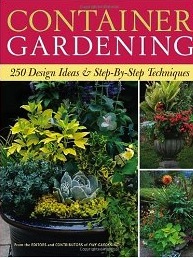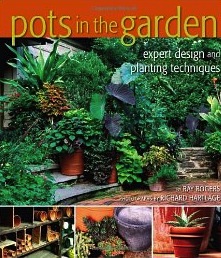Pots in the Garden: Designing, Planting & Placing Containers in the Landscape… Part One: An Introduction to Color!
 Weathered to Sweet Perfection: The Red-Orange Hue of an Old Terra Cotta Urn Complements a Carpet of Springtime Blues (Muscari armeniacum in foreground and Phlox divaricata in background)
Weathered to Sweet Perfection: The Red-Orange Hue of an Old Terra Cotta Urn Complements a Carpet of Springtime Blues (Muscari armeniacum in foreground and Phlox divaricata in background)
Late spring is the time of year when I begin planting and placing pots in the garden. Over the years, I’ve amassed quite a collection of urns, vessels, second-hand terra cotta pots and various other containers. I find that even before they are filled with colorful annuals and exotic tropical plants, their shapes, hues and textures add a touch of beauty to the landscape. In my career as a garden designer  —using my own landscape as a design lab— I’ve created a wide variety of seasonal containers for my clients. And every year, right around Memorial Day, I head out to the garden center with an open mind, looking to try something new…
 Colorful, Dramatic Pots Add a Welcoming Touch to My Studio Entry and Stone Terrace (Stonework by Vermont Artist Dan Snow, See Below for Complete Listing of Container Plants)
Colorful, Dramatic Pots Add a Welcoming Touch to My Studio Entry and Stone Terrace (Stonework by Vermont Artist Dan Snow, See Below for Complete Listing of Container Plants)
Earlier this month, I presented a seminar on container gardening,”Pots in the Garden: Designing, Planting and Placing Containers in the Landscape” sponsored by Walker Farm. Creating beautiful, annual garden displays with potted plants need not be difficult, time consuming or expensive. However, understanding the basic principles of design —as well as how to properly plant pots and follow-up with care and maintenance— is key to success with container gardening at any level. Balance and proportion, form and mass, texture and color, and line and repetition are some of the more important elements to consider whether designing a single pot, or large group of containers.
There are many decisions to make when designing a container garden, but color is always right at the top of my list. Color, like music, evokes feelings and sets mood. When designing a garden of any kind, I think about how the space will be used and what sort of feeling I want to create. If you are unfamiliar with how to work with color, the gardener’s color wheel (pictured above) can be a useful guide. When choosing a color scheme for a container garden, I keep in mind not only the foliage and flowers, but also the color of the pots, the surrounding space and nearby objects. Look carefully at walls, floors, arbors, shrubs, trees and furniture. Keep those hues in mind when designing containers for your outdoor rooms.
 Monochromatic and Analogous Color Relationships Need Not be Boring. In Fact, By Working with a Limited Palette, a Gardener can Emphasize Other Design Elements; Such as Texture, Form, Mass and Placement. Here, a Mass Planting of Orange-Hook Sedge (Ucinia egmontiana) in Oxblood-Colored Pots, Creates a Soothing Screen in Bold Color. Notice How the Orange-Red Colors Bring Out the Rusty Undertones of the Steel Deck. Bold Harmony.
Monochromatic and Analogous Color Relationships Need Not be Boring. In Fact, By Working with a Limited Palette, a Gardener can Emphasize Other Design Elements; Such as Texture, Form, Mass and Placement. Here, a Mass Planting of Orange-Hook Sedge (Ucinia egmontiana) in Oxblood-Colored Pots, Creates a Soothing Screen in Bold Color. Notice How the Orange-Red Colors Bring Out the Rusty Undertones of the Steel Deck. Bold Harmony.
When I want to set a calm and relaxing mood, I usually opt for a monochromatic color scheme; using a single color on the wheel, playing with only a few, subtle variations of tone. Notice how each color on the wheel is shaded, working toward the center? A pot with foliage and flowers in only one color can be quite beautiful. To keep such an arrangement interesting, I would play with the other elements —like form and texture— to create a dynamic design. Analogous color relationships —side by side colors on the wheel above— such as green and blue or violet and red, are also quite soothing in combination, but offer a bit more design drama…
 A Broken, Turqoise-Blue Vase adds a Bit of Drama to this Calm Arrangement. Quiet Harmony.
A Broken, Turqoise-Blue Vase adds a Bit of Drama to this Calm Arrangement. Quiet Harmony.
Things really start to get interesting in the garden when complementary colors are played off one another in a design. Opposites on the wheel, complementary colors tend to bring out the best in each other when placed close together. The more intense the hue —or strength of saturation— the more dramatic the result. For example, I like to play gold against violet. Purple, plum, maroon and lavender all look richer when they are placed near mustard, gold, honey and wheat. To bring out the beauty of violet hued foliage and flowers, I choose pots with mustard-colored glazing or add plants with golden foliage to my container design. Complementary color schemes tend to be bold and attention grabbing; use them to draw attention to an area or create a an energetic mood…
 The Golden-Chartreuse of Lysmachia nummularia (Golden Moneywort) Enriches the Angelonia (A. angustifolia ‘Angelface Blue’) in this Arrangement, and Enhances the Purple-Hues of Nearby Stobilanthes dyerianus (Persian Shield) and Verbena (Glandularia canadensis ‘Homestead Purple’)
The Golden-Chartreuse of Lysmachia nummularia (Golden Moneywort) Enriches the Angelonia (A. angustifolia ‘Angelface Blue’) in this Arrangement, and Enhances the Purple-Hues of Nearby Stobilanthes dyerianus (Persian Shield) and Verbena (Glandularia canadensis ‘Homestead Purple’)
 Simple, Mustard-Glazed Pots Work to Bring Out the Beauty of Lavender Colored Asters in This Cascading Group
Simple, Mustard-Glazed Pots Work to Bring Out the Beauty of Lavender Colored Asters in This Cascading Group
Polychromatic relationships —or mixtures of many colors— create something of a pinwheel-effect. These arrangements tend to be very bold. When I want to really jazz up a space, I will reach for the most dramatic relationships on the color wheel and spin them into a frenzy. Think outrageous succulent arrangements, tropical plants with fabulous flowers and candy colored containers. Fun!
 Blue-Hued Mexian Rose, (Echeveria ‘Pearl’) Plays off the Orange-Red Pot and a Trio of Silver and Gold-Tinted Foliage. Also Pictured Here: Variegated Elephant Bush (Portulacaria afra variegata) and Kalanchoe ‘Pumila’Â
Blue-Hued Mexian Rose, (Echeveria ‘Pearl’) Plays off the Orange-Red Pot and a Trio of Silver and Gold-Tinted Foliage. Also Pictured Here: Variegated Elephant Bush (Portulacaria afra variegata) and Kalanchoe ‘Pumila’Â
 Read More about Creating Beautiful, Bold Succulent Container Gardens by Clicking Here
Read More about Creating Beautiful, Bold Succulent Container Gardens by Clicking Here
Colorful pots can accent outdoor tables and dress up stairs, change with the seasons or to suit special occasions. Container gardens offer great opportunities to experiment with design, and yet they require minimal investment in terms of time and money. Don’t like a particular arrangement? Remove a plant or two and try something fresh! Little garden design experience? Begin with a few, inexpensive annuals and a simple pot. Fill your container with soil, keep the plants in their original pots, and try various arrangements before planting. Have a great, colorful container? Try enhancing the hue with annuals in an analogous or complementary color. As you grow more confident, reach across the color wheel for more unusual combinations and visually stunning results.
 Bright Orange Flowers Against Green Foliage are Mother Nature’s Finest Example of the Power Complementary Color Relationships. Here, My Mustard-Glazed Pot Provides an Analogous Backdrop to this Simple but Bold Display. Calibrachoa ‘Callie Orange’ Tops the Terrace Dining Table in Late May
Bright Orange Flowers Against Green Foliage are Mother Nature’s Finest Example of the Power Complementary Color Relationships. Here, My Mustard-Glazed Pot Provides an Analogous Backdrop to this Simple but Bold Display. Calibrachoa ‘Callie Orange’ Tops the Terrace Dining Table in Late May
For more inspiration, design ideas, maintenance tips and planting ideas check out some of these great, container gardening books…
 Container Gardening A Great Guide Book with Useful Information & Beautiful Photos from the Editors of Fine Gardening
Container Gardening A Great Guide Book with Useful Information & Beautiful Photos from the Editors of Fine Gardening
 Pots in the Garden Beautiful & Inspired Design Ideas from Ray Rogers (Timber Press Publishing)
Pots in the Garden Beautiful & Inspired Design Ideas from Ray Rogers (Timber Press Publishing)
Photographs and Text â“’ Michaela Medina/The Gardener’s Eden. All photographs, articles and content on this site, (with noted exceptions), are the original, copyrighted property of The Gardener’s Eden and may not be reposted, reproduced or used in any way without prior written consent. Contact information is in the left side bar. Thank you!
Do you enjoy The Gardener’s Eden? You can help support this site by shopping through affiliate links (including Amazon book links). A small percentage of each sale will be paid to this site, helping to cover web hosting and maintenance costs. Thank you so much for your support!
7 Replies to “Pots in the Garden: Designing, Planting & Placing Containers in the Landscape… Part One: An Introduction to Color!”
Comments are closed.


Hi Michaela, Ah ha, that’s what you call it! Knew there had to be more names than just “Creeping Jenny”.
May I ask what you do with your succulent pots to overwinter? I’m always afraid that they’ll get waterlogged so I bring them in – but I’d much prefer to leave them outside if at all possible – there just isn’t enough window space anymore):
Um, sorry. I didn’t mention to which plant I was referring – but I bet you already knew it was the Golden Moneywort anyway, right? I LOVE Creeping Jenny – such an amazing colour!! It’s been overwintering here amazingly well and I haven’t had to buy any now for three years: )
Hi Deb, Yes, I do overwinter the tender succulents indoors. The hardy sedum and echeveria do stay outdoors on the terrace, where the pots drain well.
Creeping Jenny is a good name. Wonder how the three Jennifers in my circle feel about it though? Ladies?
xo M
I am one of the biggest container gardeners, I swear. I plant everything in them because where I live it can get very hot, very fast and even tomatoes have difficulty living in the sun. I can freely move them around my yard to ensure they aren’t getting scorched to death, hehe.
Thanks for the informative post! I learned quite a few things.
Hope your upcoming weekend is lovely, as well.
OK, so I need one of those face containers. Any ideas about a source?
Thanks for a great post!
Hi Amanda, I’m happy to hear that you found some useful information in the post. The ability to easily move plants —to follow or avoid the sun— is indeed one of the best parts about container gardening. I hope it isn’t too hot yet in the deep south, and that you will enjoy your garden this year. Thanks for commenting ;) xo M
Hi Karen, I purchased my sun/moon pot on a road trip into Mexico years ago, and I think it’s pretty much one-of-a-kind. However, I am seeing more faces on containers these days and note that Walker Farm has a supply of very interesting “character pots” in stock.